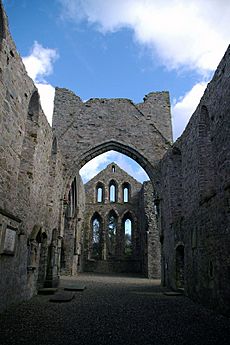Grey Abbey facts for kids
Grey Abbey is a fascinating ruined Cistercian priory located in the village of Greyabbey, County Down, Northern Ireland. It's a special place looked after by the Northern Ireland Environment Agency. You can find it near the Rosemount estate, on the eastern edge of Greyabbey village. It's a protected historic site.
History of Grey Abbey
Grey Abbey was started in 1193. It was founded by Affreca de Courcy, who was the wife of John de Courcy. Affreca was also the daughter of Godred II Olafsson, who was the King of the Isles. This abbey was a "daughter house" of Holmcultram Abbey in England.
Over time, the abbey became less important. It was officially closed in 1541. In 1572, it was burned by Brian O'Neill. Later, in 1626, Sir Hugh Montgomery took over the abbey. He put a new roof on it and fixed it up to be used as a local church. It served as a church until 1778.
Exploring Grey Abbey's Features
Grey Abbey has some unique parts that you don't often see in other Irish abbeys. One special feature is its original belfry, which is where the bells would have been.
The ruins you see today include a church with a cloister (a covered walkway) and other buildings around it to the south. You enter the church through a fancy west door. Inside, there's a nave (the main part of the church) without aisles. There are also transepts (parts that stick out like arms of a cross) with two chapels in each. The chancel (the area near the altar) is short and has tall, narrow lancet windows.
Around the cloister, you can find an chapter house with aisles. This is where the monks would meet. There's also a refectory, which was the dining hall, and it even has a reader's pulpit (a raised stand for reading). However, the western side and the cloister walkways are no longer there.
On the south wall of the nave, you can see three buttresses. These are supports that were added in the early 1900s to help preserve the building. Inside the church, in the north wall of the choir, there's a tomb with a statue of a person. Many believe this might be the tomb of Affreca, who founded the abbey. In the north transept, there's a statue of a knight in armor. This might be John de Courcy. You can also find monuments dedicated to the Montgomery family from the 1600s and 1700s.
Gallery






